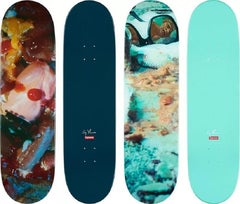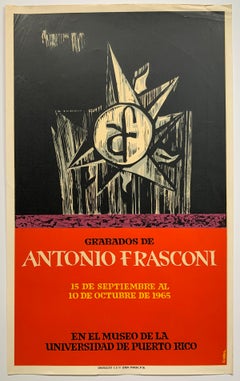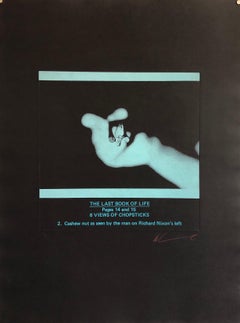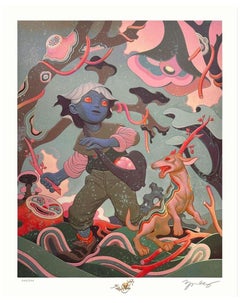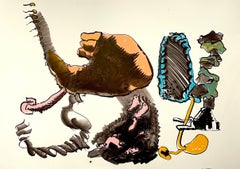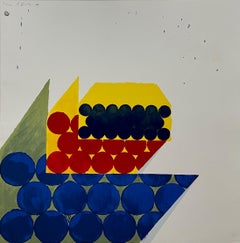Beautiful 1994 monotype painting by American artist, David Chamberlain (b.1950). Oil on Arches paper, image measures 16.5 x 21.5 inches; sheet measures 22 x 30 inches. The subtle variations of the oil application are quite lovely. Titled and signed by the artist in pencil, lower margin and on reverse. Excellent, clean condition with no damage or restoration. Unframed: sheet is loose with no backing.
SHIPS ROLLED IN TUBE
David Chamberlain (American, b Canton, Ohio 1949) has been a full-time artist since 1977, and has created more than 2000 original works in both two and three dimensions. Over 100 of his works appear in the collections of recognized arts institutions and museums, worldwide.
A serious and passionate musician (a cappella jazz singer with three recording albums and over 700 concerts in this avocation), Chamberlain's artistic approach and imagery is inspired by studies of musical patterns and relationships. Other influences include topology, poetry, design and flying.
His sculptures are noted for their playful explorations of lyrical, melodic edges and harmonious spaces. The surfaces are all one continuous form; the insides become the outsides and vice-versa; the edges are all one line. Mediums include mahogany, bronze, titanium, gold, and ceramic/porcelain.
His paintings reflect an enthusiasm for composition and improvisation. Chamberlain has developed a way to create original oil paintings using methods adapted from monotype processes incorporating a light table and mirrors, an etching press, and a variety of hands-on tools (including fingers, rollers, static electricity and blowing)... but no brushes.
This method, sometimes called the Chamberlain Method, makes possible the intense collaborations he is known for, where he and another artist work on the same painting at the same time. Called Duett Painting, this mutual and simultaneous way for two artists to paint together attempts to involve the backgrounds of each, directly and profoundly. There are no rules, and there is no place to hide whoever the artists are appears in the composition. As each artist's marks influence the other's, the painting takes on a momentum of its own, compelling the artists toward a new direction neither would have pursued on their own.
Chamberlain has worked with over 100 artists, musicians, dancers, poets and creative people from the USA, Asia, Europe, South America and Africa. About half of his paintings are collaborative duetts; half are conventional solo works using these techniques.
His studio is based near Boulder, Colorado. He is married, with two children, a dog and three cats.
EDUCATION
MLA University of Colorado 2002
Landscape Architecture
MFA University of Pennsylvania 1977
Sculpture & Printmaking
BA Princeton University 1971
Architecture & Design
SELECTED
EXHIBITIONS
Consulate of Japan, San Francisco, CA 1999, 1998
Major Shows Muse a Muse' Gallery, Tokyo, Japan 1997, 1999
Retrospective: "Solos, Duets & Concertos" Muskegon Mus. of Art, MI 1996
"Duets" Delaware Museum of Art, Wilmington, DE 1995
MacLaren/Markowitz Gallery, Boulder, CO 1991
Retrospective: McKissick Museum of Art, Columbia, SC 1990
Retrospective: The Art Complex Museum, Duxbury, MA 1988
Pucker Gallery, Boston, MA 1981, 1984, 1988
Gibson Gallery, SUNY at Potsdam, NY 1987
Arlene McDaniel Galleries, Simsbury, CT 1986
Lyme Academy of Fine Arts, Old Lyme, CT 1985, 1986
Gallerie Obussier, Nantucket, MA 1985
New Acquisitions Gallery, Syracuse, NY 1983
Everson Museum of Art, Syracuse, NY 1983
COMMISSIONS:
Operhall Suite; [Series of 6 original works] Muskegon Museum of Art 1994
Symphony Suite; Gibbes Museum & Charleston Symphony Orchestra 1994
Gospel Suite in F; New England Conservatory of Music, Boston, MA 1994
Eroica; Morgridge Auditorium, University of Wisconsin, Madison, WI 1992
Balletté; Southworth Library, Canton College, Canton, NY 1991
A Une Passante; M. C. Wallace Library, Wheaton College, Norton, MA 1991
Festivale; K. B. K. Foundation, Boston, MA 1990
A Une Passante; SUNY Potsdam, Potsdam, NY 1989
Balletté; Ensign-Bickford Corp., Simsbury, CT 1987
Torus; Stratus Computer, Inc., Marlboro, MA 1986
Rondella; BNWC, Brandeis University, Waltham, MA 1985
Viole, Ayre; Asset Management, Inc., Essex, CT 1983
Cantata; Horne Library, Babson College, Wellesley, MA 1981
COLLECTIONS
Museums Art Complex Museum, Duxbury, MA
Ashmolean Museum, Oxford University, England
Asian Art Museum, San Francisco, CA
British Museum, London, England
Columbia Museum of Art, Columbia, SC
Currier Gallery & Museum, Manchester, NH
Danforth Museum, Framingham, MA
Davis Museum of Art, Wellesley, MA
DeCordova Museum, Linclon, MA
Delaware Museum of Art, Wilmington, DE
Denver Art Museum, Denver, CO
Detroit Institute of Arts, Detroit, MI
Everson Museum of Art, Syracuse, NY
Farnsworth Museum of Art, Rockland, ME
Fine Arts Center at Cheekwood, Nashville,TN
Fitzwilliam Museum, Cambridge University, England
Gibbes Museum of Art, Charleston, SC
Gibson Gallery & Museum, SUNY Potsdam, NY
Greenville County Art Msueum, Greenville, SC
Hara Museum of Contemporary Art, Tokyo, Japan
Johnson Museum of Art, Ithaca, NY
McKissick Museum of Art, Columbia, SC
Minneapolis Institute of Art, Minneapolis, MN
Munson-Williams-Proctor Institute of Art, Utica, NY
Museum of Fine Arts, Boston, MA
Museum of Fine Arts, Springfield, MA
Muskegon Museum of Art, Muskegon, MI
National Museum of American Art, Washington, DC
Nelson Museum of Art, Kansas City, MO
New Britain Museum of American Art, New Britain, CT
Portland Museum of Art, Portland, ME
Portland Art Museum, Portland, OR
Princeton University Art Museum, Princeton, NJ
Rose Art Museum, Waltham, MA
San Diego Museum, San Diego, CA
Smith College Museum of Art, Northampton, MA
Taylor Museum/CSFAC, Colorado Springs, CO
University of Michigan Museum of Art, Ann Arbor, MI
Victoria & Albert Museum, London, England
Wadsworth Athenaeum, Hartford, CT
Williams College Museum of Art, Williamstown, MA
Yale University Art Gallery, New Haven, CT
Institutions American Embassy, Tokyo, Japan
[selected] Arjo Wiggins/Arches S.A., Annonay, France
Bank of America, Boston, MA
Boso Yusi Company, Tokyo, Japan
Boston Ballet, Boston, MA
Canadian Foreign Ministry, Ottawa, Canada
Chase Manhattan Bank, Vietnam
Embassy of Japan, Abu Dhabi, United Arab Emirates
FIA Institute, Tokyo, Japan
Fidelity Ventures & Associates, Boston, MA
Frederik Meijer Sculpture Gardens, Grand Rapids, MI
Gauteng Legislature, Gauteng, South Africa
German Embassy to Vietnam, Hanoi, Vietnam
Helix Technology Corporation, Longmont, CO
Ito-En Company, Tokyo, Japan
JAFCO America Ventures, Boston, Palo Alto, Tokyo
Japanese Consulates: Boston, MA; Atlanta, GA; San Francisco, CA
Japanese Foreign Ministry, Tokyo, Japan
Japan External Trade Organization, New York, Tokyo
Kepner-Tregoe Company, Princeton, NJ
Kobe Steel, Ltd Tokyo, Kobe
Mochida Medicines, Inc., Tokyo
Monsanto, European Division, Brussels, Belgium
New England Conservatory of Music, Boston, MA
Nueva Set-Kei, Inc. Tokyo, Japan
Opinion Research Company, Princeton, NJ
PAR Associates, Inc., Boston, MA
Price, Waterhouse & Company, Greenwich, CT
Princeton Club of Japan, Tokyo, Japan
Saint Joseph's Heart Hospital, Lexington, KY
Spencer, Fane & Browne; Shugert & Thomson, Kansas City, MO
Temple Society of Concord, Syracuse, NY
T. Rowe Price, Inc., Colorado Springs, CO
University of Wisconsin School of Business, Madison, WI
Vietnam Embassy to Canada, Ottawa, Canada
Yankelovich, Skelly & White, Stamford, CT
COLLABORATIONS
Johannesburg, South Africa (& Artist Proof Studio) 1997
Duetts with: Kagiso Pat Mautloa, Durant Sihlali, Mmakgabo Sebidi, Dumisane Mabaso, Nhlanhla Xaba, Pepe Abela, Vincent Baloyi, Ntepe Osiah Masekwameng, Gordon Gabashane, Sokhaya Nkosi
Vietnam (& Indochina Arts Project) 1995
Fine Arts Associations, Saigon, Hue and Hanoi; Ecole des Beaux Arts, Hanoi
Duetts with: Do Minh Tam, Hoc Hai, Huy Oanh, Le Anh Van, Le Thong, Le Van Suu, Manh Tuan, Mai Khanh, Nghia Duyen, Thuc Ban, Tran Khan Chuong, Tran Luong
Studio Duetts 1995-2001
With: Yuji Kishimoto (Architect -- Japan/USA), Emi Tajima (Japanese master caligrapher), Nguyen Quynh Nhu (Vietnam), Eduardo Chavez & Arturo Miranda (Mexico), Kyi May Kaung (Burmese Poet), Patrick Moraz (Swiss/American composer/performer), Jingalu (Aboriginal Australian artist), Rungsak Dokbua (Thailand), and Americans Don Grusin (Composer/performer), Dave Grusin (Composer/performer), Harry Skoler (Composer/performer), Sarah Schneider (Dancer/choreographer), Sally Ranney (artist/humanist), Cleo Parker Robinson (Dancer/choreographer)
China (PRC) 2001-2004
Proposal for an Artistic Collaboration with China, 2001-2004 (38 pages). Involving ten Chinese Artists, streaming on the internet, development of 160 museum-quality Duett paintings for world-wide exhibition; budget 1.6 million USD.
HIGHER EDUCATION
Visiting Artist [Associate Professor One-year appointment] 1990/1991
Art Department, University of South Carolina
Adjunct Professor 1991-1994
Art Department, Rivier College, Nashua, NH
Fellow/Panelist
The Aspen Institute Aspen, CO 2000
Conference on World Affairs [Univ of Colo, Boulder] 1990-1998
Visiting Artist
Haverford School, Bryn Mawr, PA 1999
Clemson University, Clemson, SC 1997, 1998
African Institute of Art, FUNDA Soweto, South Africa 1997
Princeton University 1996
Williams College 1995
Bradford College 1994, 1998
College of Charleston 1994
University of Pennsylvania 1993
University of South Carolina 1990, 1994
SUNY Albany 1992, 1993
Pine Manor College 1987, 1989
Bentley College 1988
Simon's Rock/Bard College 1988
Brandeis University 1986
Lyme Academy of Fine Arts 1985, 1986
Emerson College 1985
Harvard University 1984, 1985
Mount Holyoke College 1984
Syracuse University 1983
Colorado College 1977
Director; Artist in Residence 1974-1977
Arts College House, University of Pennsylvania
Taught Drawing (figure & still-life) and Photography
Initiated Interdisciplinary Program: Dance, Music, Poetry, Theatre, Film, Architecture, Art
SCHOOLS & PROGRAMS
Instructor, Photography & Visual Arts 1974-1976
Adirondack Lakes Center for the Arts
Chair, Performing Arts Department 1971-1974
Purnell School
Instructor, Visual Arts Department 1970-1974
Purnell School [Taught (& developed syllabi for) 21 Studio arts courses]
Juror, College Entrance Examination Board Area: Fine Arts 1972
AWARDS
Selection Who's Who: in American Art; in the East; in the World
Grants Krasner-Pollack Foundation Emergency Grant, 1999
Indochina Arts Project (Ford Foundation) 1994
Individual Artist Grant, South Carolina Arts Commission 1991
K. B. K. Foundation, 1991, 1994
High Meadow Foundation, 1990
Ford Venture Fund Grant [Univ. of Pennsylvania] 1975-1977
Haas Memorial Fund Fellowship, 1976
GRANTS IN KIND
Kodak, Rochester, NY
Papeteries Canson & Montgolfier, Annonay, France; Royal
Talens BV Oil Paints, Apeldoorn, Holland
Takach Etching Press Corp., Albuquerque, NM
South African Airlines; American Airlines
Korean Airline;
Trans World Airlines
PUBLICATIONS
Film segmant Video Jukebox DeCordova Museum of Art, Linclon, MA 1999
Film David Chamberlain: Artistry in Motion {30 minutes} SC-ETV/PBS 1992
Book Melodic Forms: The Sculpture of David Chamberlain {75 pages, color} 1990
David Godine, Publisher Boston, MA
Videotape Search for Perfection; {16 minutes} FIS/Pucker Safrai 1982
Award: Red Ribbon Category: The Arts American Film Festival, New York
INTERVIEWS
All Things Considered, National Public Radio
Weekend Edition, Monitor Radio & Public Radio International
CNN Headline News, Atlanta, GA
International News Scene, Reuters Press International, New York/Hong Kong
Terra Infirma, Corp. for Public Broadcasting
BBC World, London
Art Scene, S. Carolina Public Radio
Jazz Times, Blue Lakes Public Radio, Grand Rapids, MI
Conversations with Jean Feraca, Wisc. Public Radio, Madison, WI
WBZ-TV Boston, MA
WCNY-TV Syracuse, NY
WNPE-TV Watertown, NY
WSBK-TV Boston, MA
WERS-Radio Boston, MA
RELATED EXPERIENCE
Designs Arts College House (Program) ; University of Pennsylvania, Philadelphia, PA 1975
Performing Arts Center (Architectural); Purnell School, Pottersville, NJ 1973
Fine Arts Center (Architectural); Purnell School, Pottersville, NJ 1971
Diplome Centre Audio Visuel Langues Modernes, Vichy, France 1973
School for International Training, Experiment in International Living, Putney, VT 1973
Graduate Credits Teaching Studio Art Institute, Colorado College, 1972
Consultant Sculpture Walk Project Univ. of South Carolina, Architectural Facilities Planning 1990/91
"How to create, fund and impliment a self-sufficient world-class sculpture collection"
Speaker "[Man] In The Arena" , Haverford School, Haverford, PA 2000
"Architecture & Painting" Clemson University Dept of Art & Architecture, AIA Lecture 1997 Reflections on Creativity" Am. Inst. of Architects Convention, Highlands, NC 1994
"Neurons, Notes & Sketches", Conference on Art & Mathematics Albany, NY 1993
"Music into Sculpture", Conference on Art & Mathematics Albany, NY 1992
"On the Creative Process", Empire State Plaza Art Collection Albany, NY 1993
"Creativity and Fullfillment", Conference on Health & Spirituality Boston, MA 1991
Vocalist & Cahoots (jazz a cappella quartet) 1974-present Album Recordings: "Released" (1993) ;
Arranger "Haven't We Met" (1991); All Good Children (octet) 1972-74 Album: "All Good
Children" (1980); Canto Ergo Sum (sextet) 1971-72; The Footnotes (double sextet)
1967-1971 Album: "
Another Summer...
